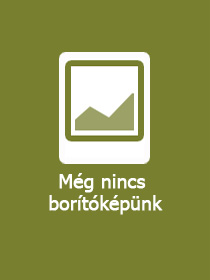
Remote Sensing of Night-time Light
-
20% KEDVEZMÉNY?
- A kedvezmény csak az 'Értesítés a kedvenc témákról' hírlevelünk címzettjeinek rendeléseire érvényes.
- Kiadói listaár GBP 41.99
-
21 251 Ft (20 239 Ft + 5% áfa)
Az ár azért becsült, mert a rendelés pillanatában nem lehet pontosan tudni, hogy a beérkezéskor milyen lesz a forint árfolyama az adott termék eredeti devizájához képest. Ha a forint romlana, kissé többet, ha javulna, kissé kevesebbet kell majd fizetnie.
- Kedvezmény(ek) 20% (cc. 4 250 Ft off)
- Discounted price 17 001 Ft (16 191 Ft + 5% áfa)
Iratkozzon fel most és részesüljön kedvezőbb árainkból!
Feliratkozom
21 251 Ft

Beszerezhetőség
Becsült beszerzési idő: A Prosperónál jelenleg nincsen raktáron, de a kiadónál igen. Beszerzés kb. 3-5 hét..
A Prosperónál jelenleg nincsen raktáron.
Why don't you give exact delivery time?
A beszerzés időigényét az eddigi tapasztalatokra alapozva adjuk meg. Azért becsült, mert a terméket külföldről hozzuk be, így a kiadó kiszolgálásának pillanatnyi gyorsaságától is függ. A megadottnál gyorsabb és lassabb szállítás is elképzelhető, de mindent megteszünk, hogy Ön a lehető leghamarabb jusson hozzá a termékhez.
A termék adatai:
- Kiadás sorszáma 1
- Kiadó Routledge
- Megjelenés dátuma 2023. szeptember 25.
- ISBN 9780367769888
- Kötéstípus Puhakötés
- Terjedelem310 oldal
- Méret 246x174 mm
- Súly 570 g
- Nyelv angol 540
Kategóriák
Rövid leírás:
This book captures key methodological issues associated with pre-processing night-time light data, documents state of the art analysis methods, and explores a wide range of applications.
TöbbHosszú leírás:
Satellite images acquired at night provide a visually arresting perspective of the Earth and the human activities that light up the otherwise mostly dark Earth. These night-time light satellite images can be compiled into a geospatial time series that represent an invaluable source of information for both the natural and social sciences. Night-time light remote sensing has been shown to be particularly useful for a range of natural science and social science applications, including studies relating to urban development, demography, sociology, fishing activity, light pollution and the consequences of civil war. Key sensors for these time-series include the Defense Meteorological Satellite Program?s Operational Linescan System (DMSP/OLS) and the Suomi National Polar-orbiting Partnership Satellite?s Visible Infrared Imaging Radiometer Suite Day/Night Band (Suomi NPP/VIIRS DNB). An increasing number of alternative sources are also available, including high spatial resolution and multispectral sensors.
This book captures key methodological issues associated with pre-processing night-time light data, documents state of the art analysis methods, and explores a wide range of applications. Major sections focus on NPP/VIIRS DNB processing; inter-calibration between NPP/VIIRS and DMPS/OLS; applications associated with socio-economic activities, applications in monitoring urbanization; and fishing activity monitoring.
The chapters in this book were originally published as a special issue of the International Journal of Remote Sensing.
TöbbTartalomjegyzék:
Preface: Remote sensing of night-time light
Xi Li, Christopher Elvidge, Yuyu Zhou, Changyong Cao and Timothy A. Warner
1. VIIRS nighttime lights
Christopher D Elvidge, Kimberly Baugh, Mikhail Zhizhin, Feng Chi Hsu and Tilottama Ghosh
2. Assessment of straylight correction performance for the VIIRS day/night band using Dome-C and Greenland under lunar illumination
Shi Qiu, Xi Shao, Chang Yong Cao, Sirish Uprety and Wen Hui Wang
3. Improving accuracy of economic estimations with VIIRS DNB image products
Naizhuo Zhao, Feng-Chi Hsu, Guofeng Cao and Eric L. Samson
4. A new multichannel threshold algorithm based on radiative transfer characteristics for detecting fog/ low stratus using night-time NPP/VIIRS data.
Shensen Hu, Shuo Ma, Wei Yan, Jun Jiang and Yunxian Huang
5. Intercalibration between DMSP/OLS and VIIRS night-time light images to evaluate city light dynamics of Syria?s major human settlement during Syrian Civil War
Xi Li, Deren Li, Huimin Xu and Chuanqing Wu
6. Outdoor light and breast cancer incidence: a comparative analysis of DMSP and VIIRS-DNB satellite data
Nataliya A. Rybnikova and Boris A. Portnov
7. Using multitemporal night-time lights data to compare regional development in Russia and China, 1992?2012
Mia M. Bennett and Laurence C. Smith
8. The short-term economic impact of tropical Cyclone Pam: an analysis using VIIRS nightlight satellite imagery
Preeya Mohan and Eric Strobl
9. Port economics comprehensive scores for major cities in the Yangtze Valley, China using the DMSPOLS night-time light imagery
Chang Li, Guangping Chen, Jing Luo, Shice Li and Jia Ye
10. Urban mapping using DMSP/OLS stable night-time light: a review
Xuecao Li and Yuyu Zhou
11. Analysis of urbanization dynamics in mainland China using pixel-based night-time light trajectories from 1992 to 2013
Yang Ju, Iryna Dronova, Qin Ma and Xiang Zhang
12. Assessing urban growth dynamics of major Southeast Asian cities using Night-Time Light data
Shankar Acharya Kamarajugedda, Pradeep V Mandapaka and Edmond Y.M Lo
13. A Novel Method for Urban Area Extraction from VIIRS DNB and MODIS NDVI Data: A Case Study of Chinese Cities
Qiao Zhang, Ping Wang, Hui Chen, Qinglun Huang, Hongbing Jiang, Zijian Zhang, Yanmei Zhang, Xiang Luo and Shujuan Sun
14. Monitoring urban expansion using time series of night-time light data: a case study in Wuhan, China
Xin Xin, Bin Liu, Kaichang Di, Zhe Zhu, Zhongyuan Zhao, Jia Liu, Zongyu Yue and Guo Zhang
15. Predicting potential fishing zones of Japanese common squid (Todarodes pacificus) using remotely sensed images in coastal waters of south-western Hokkaido, Japan
Xun Zhang, Sei-Ichi Saitoh and Toru Hirawake
Több



